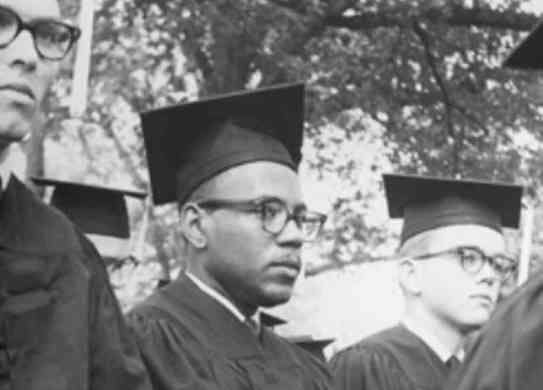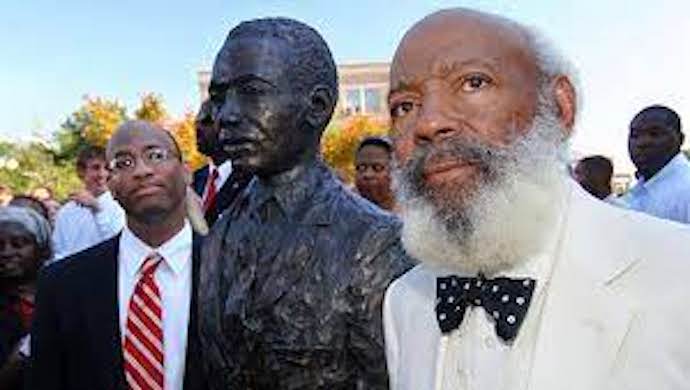Examining the Integration Struggle, a Civil War Unto Itself
As the first African American to enroll at the University of Mississippi, James Meredith was at the center of a struggle the depths of which even Faulkner did not fully imagine.

‘James Meredith: Breaking the Barrier’
Edited by Kathleen Wickham
Yoknapatawpha Press, 162 pages
‘We Believed We Were Immortal: Twelve Reporters Who Covered the 1962 Integration Crisis at Ole Miss’
By Kathleen Wickham
Yoknapatawpha Press, 246 pages
‘Riot: Witness to Anger and Change’
By Edwin E. Meek, Edited by Lawrence Wells
Yoknapatawpha Press, 160 pages
As James Meredith was on his way to becoming the first African American to enroll at the University of Mississippi, a riot broke out on campus September 30, 1962. Schools had remained segregated in spite of the 1954 Supreme Court decision, and as William Faulkner had forecast, violence arrived when the federal government enforced integration.
The plan was to murder Mr. Meredith, as Kathleen Wickham recounts in “We Believed We Were Immortal.” One of the key players was Faulkner’s nephew, Jimmy Faulkner. The Air Force veteran drove a bulldozer onto campus toward the Lyceum, where wounded Union soldiers had once been housed. It was there that U.S. Marshals protected Mr. Meredith after Mississippi law enforcement had withdrawn.
Jimmy Faulkner had not counted on his brother, Murry, a member of the federalized Mississippi National Guard, standing in his way. At the last moment, Jimmy veered away from his brother and drove the bulldozer into a tree, hoping to use that as cover for riflemen who would shoot and storm the Lyceum, but the FBI swarmed over the bulldozer as Jimmy fled, never to be apprehended.
When William Faulkner predicted violence, he never imagined it would be brother against brother, even though that is what happened in his Civil War novel, “Absalom, Absalom!” Yet Jimmy’s brother had taken an oath to the United States, and he was determined to abide by it.
In the fall of 1962, two months after Faulkner had died, even Thurgood Marshall thought Mr. Meredith was crazy to confront segregation in the most reactionary Southern state, as you will learn in “James Meredith: Breaking the Barrier.”
In Ms. Wickman’s important collection of articles by and about Mr. Meredith and the desegregation of Ole Miss, you will discover a composite biography, documented with superb period photographs, that not even this country’s greatest novelist could have imagined.
Mr. Meredith, in his own words and those of others who watched him, was not a movement man. He was always his own man, determined to force an entire state to capitulate to his desire to be recognized, as he put it, as an American citizen.

An Air Force veteran, Mr. Meredith had served in Japan in the 1950s at the time Faulkner visited. Did Faulkner notice, as Mr. Meredith did, that African Americans serving there were treated as equals? Mr. Meredith decided, right then, he would return home and liberate an entire state: liberate not only his fellow African Americans but white citizens, prisoners of discrimination and hate.
Like Faulkner’s Lucas Beauchamp, that larger than life figure in “Go Down, Moses” and “Intruder in the Dust,” Mr. Meredith was fearless. Beauchamp grows up on a piece of land his white masters have carved out of a plantation as his own domain. Mr. Meredith hailed from Kosciusko, Mississippi, the ancestral home of Faulkner’s wife, Estelle, on a piece of property that his father had established to protect his son from precisely those people who would later try to murder him.
Faulkner could not conceive of an African American as courageous as Mr. Meredith, and yet Mr. Meredith confirmed the great novelist’s conviction that only individuals, not movements, would change history. Only when Mr. Meredith refused to pull out of what looked like a suicidal quest did Marshall, Robert Kennedy, and the weight of the federal government come down on his side.
Yet the story, as with that confrontation between brothers, is far more complex, with the editor of Ole Miss’s student newspaper supporting Mr. Meredith’s right to enroll and later, much later, being awarded for her stance, rescinding an earlier censure of her for doing so.
The stories of a Black journalist and others showing how dangerous it was to report the story of Mr. Meredith’s heroic quest make “James Meredith: Breaking the Barrier” essential reading, along with Edwin Meek’s photographs in “Riot” that record what happened when an American university campus became a “war zone.”
Mr. Rollyson is the author of “Uses of the Past in the Novels of William Faulkner” and, with Lisa Paddock, “Thurgood Marshall: Perseverance for Justice.”

